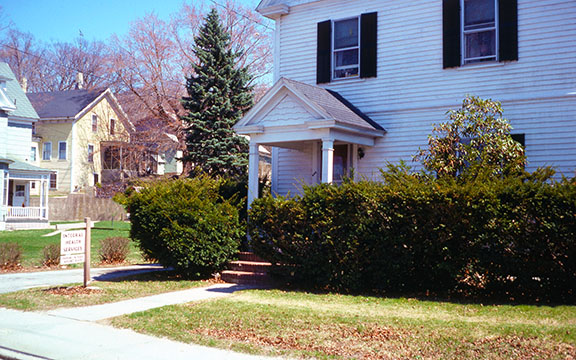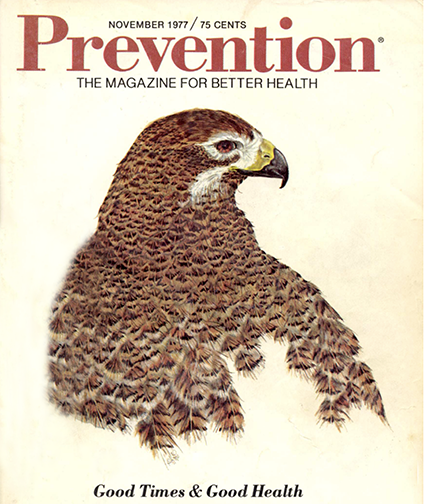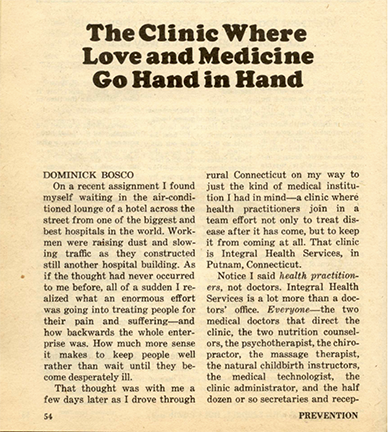
(photo: Integral Health Services, 1977.)
In November 1977, Prevention magazine published the first of two articles about Integral Health Services—a groundbreaking integrative medicine clinic in Connecticut. Possibly the first health center of its kind in North America (and even the world), it was based on the teachings and practices of Integral Yoga. Swami Satchidananda, the founder of Integral Yoga, worked closely with Dr. Sandra (Amrita) McLanahan (a student of and physician to Swami Satchidananda), the medical director of this health center, to establish a trailblazing endeavor to bring the best wellness practices together in a comprehensive and integrated approach to health care. This approach would later be named: Lifestyle Medicine. As you read this article, it’s interesting to reflect on how revolutionary (and really unheard of) they were at this time! Here is the first of the two articles originally published in Prevention and written by Dominick Bosco.
On a recent assignment I was waiting in the air conditioned lounge of a hotel across the street from one of the biggest and best hospitals in the world. Workmen were raising dust and slowing traffic as they constructed still another hospital building. As if the thought had never occurred to me before, all of a sudden I realized what an enormous effort was going into treating people for their pain and suffering—and how backwards the whole enterprise was. How much more sense it makes to keep people well rather than wait until they become desperately ill.
That thought was with me a few days later as I drove through rural Connecticut on my way to just the kind of medical institution I had in mind—a clinic where health practitioners join in a team effort not only to treat disease after it has come, but to keep it from coming at all. That clinic is Integral Health Services, in Putnam, Connecticut.
Notice I said health practitioners, not doctors. Integral Health Services is a lot more than a doctor’s office. Everyone—the two medical doctors that direct the clinic, the two nutrition counselors, the psychotherapist, the chiropractor, the massage therapist, the natural childbirth instructors, the medical technologist, the clinic administrator, and the half dozen or so secretaries and receptionists—joins in the health-producing effort.
So on a July evening, as passing thunderstorms washed the midsummer swelter out of the air, I sat in the reception room—which was more like a cozy living room—with all of these people and listened to the story of Integral Health Services.

(Dr. McLanahan & Yoga pose on wall of her office, 1977.)
Sandra McLanahan, M.D., medical director: We’re really interested in providing integral health. That’s why we chose that title. Integral health means working with the body, the mind, and also trying to see the whole life of the person. Disease usually doesn’t come without a reason. There’s something in the way you live your life that leads to these debilities that cause disease. So we look for them before the disease is there, so we’re really getting at the root cause. For example, while we’re treating someone’s pneumonia, we get them to quit smoking, too.
We’re dedicated to offering this preventive approach to all kinds of people, from whatever background. About 60 percent of the people who come here specifically request the preventive counseling. And about 40 percent come because they’re looking for a doctor they can get along with. We have a family practice clinic, so we encourage people to come as families.
Dwight L. McKee, M.D., associate medical director: About 70 to 80 percent of our patients are from northeastern Connecticut. But we’re getting more and more from Boston, New York City, and all over New England. Some have come from Hawaii, too. They come here because medicine is getting to the point where bigger and bigger hospitals do not mean that we’re healthier and healthier. When I was in my internship, I got to know a few older doctors, good, caring people who were highly respected and well-published in their fields. But they said many times if they had to do it all over again, they’d do something else. Deep inside, many of them were really frustrated. They knew they were on a treadmill, that what they were doing produced no lasting change. They could see the futility in the tools they had to work with, but they didn’t know any other tools.
Individualized Treatment
Dr. McLanahan: The nice thing about this clinic is that nothing is done routinely. We’re not geared to one particular approach. We try to have a number of tools available and use them according to the individual needs of the person. We deal with the root causes of disease. We see health not as an end, but as a means to fulfiling our own, loving nature. I like to define medicine in that sense, not to limit it to the mere functioning of the vehicle, but to include what the vehicle is doing, where it is going.
Thomas Krell, administrator: We try to teach people how to help themselves. Hopefully, we won’t see them too much after a while. They’ll learn how to stay well.
Dr. McLanahan: The most common problems we see are the most common problems in the country: obesity, cigarette smoking, alcohol, allergies, asthma, arthritis, heart disease, and cancer. We like to get people before they have a specific complaint. But once a person does have a complaint, it’s a great time to teach that person. We look at it as a teaching opportunity, not as an opportunity to write a prescription and send them away. We want to keep them, help them not make the same mistake that brought them
to the point of pain. That’s the key focus of this clinic. It’s not just that we have exotic tools. You can get caught up in fancy tools. The main thing is to focus on the person’s life, the way they live it. Even if you give them a remedy, if they continue making the same mistake, the symptom, the pain, will come back.
Prevention: What are the first few steps when a person comes here?

(Cover of November 1977 issue)
Dr. McLanahan: The first thing we do is get the person’s history of illnesses and diet. Then we do a complete physical. They also tell us about factors in their lives that produce stress, their jobs, their lifestyle, whether they fasten their seat belts. We also look at aspect of their health which nutrition affects early, such as the condition of their hair, nails, eyes, skin. Sometimes, we do a hair analysis. We also consider if the person needs some psychological counseling. And we usually have everyone see the nutritionist at least once or twice. Depending on what their problems is, we might also have them see the massage therapist or chiropractor.
Dr. McKee: A number of patients come first to see the nutritionist. They don’t have to go through the medical doctors first. Or they may come to see the chiropractor first. And if they have a problem that needs further work, we refer them to another practitioner at the clinic.
We sometimes use therapeutic massage as a diagnostic tool, too. The massage Steve does is based on the same principles as acupuncture. It’s called shiatsu massage. In fact, it’s probably older than acupuncture. I’ve gotten very valuable diagnostic information from him by finding out which meridians are particularly sore. If somebody comes in with a lot of vague complaints but nothing specific turns up on the regular physical, their sensitivity to the various shiatsu massage points can tell me what particular organ needs treatment. I’ve found that directing the nutritional therapy along those lines, at that particular organ, is very successful.
Dr. McLanahan: One useful aspect of this clinic is that you can see all the different ways of looking at things, the different contributions. We really try to use the knowledge that each practitioner brings. We try to get the whole picture. Many times the person will say things to the nutritionist that he or she wouldn’t feel comfortable saying to the M.D. But we all communicate among ourselves very well.
Prevention: Obviously, the setup here is quite different from what you would find in most clinics.
Dr. McLanahan: Yes, but we feel that there’s no conflict between what we do here and traditional medical practice. Some of these tools, nutrition and Yoga, are extensions of what has been done in the past.
Mr. Krell: Contemporary forms of medical treatment are not overlooked here. We try to approach people on their own level. But the tools are made available too.
Alternative Approaches Sought

(First page of Prevention magazine article)
Dr. McLanahan: There’s a lot more interest in preventive medicine today than there used to be. People are becoming aware of how important the diet is, how it contributes to health and disease. I’ve been speaking at various medical schools and recently I spoke at the American Medical Students’ Association convention in Chicago. The entire convention was oriented toward alternative approaches in medicine.
Dr. McKee: Hippocrates said food is the best medicine. The traditions were there but somehow they were gradually set aside. Perhaps because of the dramatic results with drugs.
Prevention: Speaking of food as medicine, Kent, how do you approach people when they come to you?
Kent Garrison, nutritionist: One of the things I like to do when counseling people is sort of demystify health. People are led to believe that the masters of medical technology are the only ones who understand health. But I like to emphasize that health doesn’t come from a drug. Health comes from the soil, that is, from our food. We evolved in such a way that our body assimilates certain foods best—and you can bet refined foods don’t fall into that category. In a sense, eating a whole foods diet with natural foods grown organically in healthy soil is nowadays considered therapeutic. That’s a funny twist. It show how far we’ve gone, when a normal diet is considered therapeutic!
Prevention: What sort of diet do you recommend generally?
Dr. McLanahan: We recommend that at least 50 percent of the diet be raw foods. That simply means a salad and fresh fruit every day. In the summertime, we recommend that the diet be 90 percent raw, since more fresh fruits and vegetables are available. Whether the person eats meat or dairy products is really up to his or her individual preference. We don’t recommend one way or the other, although we lean toward vegetarianism.
Dr. McKee: We don’t try to push vegetarianism on them. We say “meats, if desired,” on the diet sheets. Of course, we think vegetarianism has health advantages—but it’s up to the individual to decide.
Avoid Refined Food
Dr. McLanahan: We do recommend avoiding refined foods. And if vegetables must be cooked, they should be steamed, not boiled. What we try to emphasize are simplicity, purity, and moderation. Simplicity is eating food the way it comes. If you can hold it in your hands the way it came from nature, then we recommend eating it. Unfortunately, we are taught that it’s a lot more exciting to have apple pie, apple betty, and apple tarts than it is to have an apple.
Purity means that the food should as much as possible be organically grown. As for moderation, there’s an ancient Indian proverb: “You’ll never have need of medicine or a doctor if you just take care never to eat until you’ve digested what you ate before.” Food is just constantly piling in on us at all the wrong times in all the wrong combinations.
Prevention: Do you ever use supplements therapeutically ?
Dr. McLanahan: It depends on the individual patient. We try to adapt it to their needs. Some people need more of certain kinds of nutrients than others.
Mr. Garrison: I would like to see people get all their nutrients from whole foods. But in many cases they have a nutritional deficiency because of all the refined foods they’ve eaten over the years. So, in some cases, we do recommend supplements.
Dr. McKee: One of the things I find myself doing in my practice a great deal is using digestive supplements to help people repair their digestion when it’s broken down. I use enzymes, hydrochloric acid, pepsin—and we have a procedure for cleansing the gallbladder. Then they are able to deal better with normal nutrition. They can digest and assimilate. You’re not what you eat, you’re what gets to your cells.
Prevention: Sandra, a few minutes ago, you mentioned “the whole picture.” There’s more to that than the physical exam, am I right?
Dr. McLanahan: In medicine, you deal so much with the physical body. I think it’s important to balance ourselves. Our culture deals so much with the physical. But just to have a healthy body isn’t enough. We have to address ourselves to the ultimate question: “What are we here for?” When you have that healthy body, what do you do with it? I believe the only action that’s going to be ultimately satisfying is to give and experience love. I guess that’s the ultimate aim of this clinic, to give and experience that love with our patients and each other and the health that comes with it.
Dyrian Benz, M.A., counselor, psychotherapist: Some of the people I see tell me that the very reason they’re here is for that very reason—they’re here for that combined approach. Because the doctors really spend time with them and they look at their way of living and it’s not just an exam of physical things. It takes much more into account.
Stress Causes Disease

(photo: Dyrian Benz speaks with a patient, 1977.)
Dr. McLanahan: For example, I would say that the root cause of most disease in this country is stress. Stress leads to the cigarette smoking, the alcohol, the overeating, the wrong kinds of foods, drugs. Because of all this stress and tension, people feel this separateness, this loneliness and despair. And those things really have to be dealt with before the symptoms can be removed.
Mr. Benz: One of the simple things we do is teach people how to relax. Just a simple tool like that. And when someone learns how to relax, it’s amazing how their outlook changes and how their health improves so much. Just by looking at things in a more relaxed state of mind they’re able to not be so uptight when something happens. They can deal with it effectively.
Prevention: Don’t a lot of people go to a doctor expecting a quick cure for their problems? You know, “I don’t want to learn how to relax, I want some Valium.”
Dr. McLanahan: Our society is so goal-oriented. Everything has got to have a goal. But it can make you miss the value of the moment. Also, a lot of people run on the treadmill “more is better” until they completely exhaust themselves. You know, Valium is the most frequently prescribed drug in this country. Where did we come by this cultural Valium deficiency? Where did we come by it? By the stress in our lives, and covering up the stress with something else.
Mr. Krell: People spend a good portion of their income getting sick. In the standard approach to
disease, you come in to see your physician for a few minutes, he puts something in you and you go away. That’s it. But it takes time to get well—not nearly as long as it took to get sick, though. So understand that when people working with holistic medicine, the care is more intensive. It requires a bit more time.
Dr. McLanahan: We are all here to help each other. We need to work with each other. It’s difficult, the bad practices have gotten so entrenched in us. So it’s easy to slip back. You see how joyful children are naturally. That’s our true nature, if we don’t muck it up with our eating habits and a lot of other things. We try to take some of that muck, that lamp black off.

